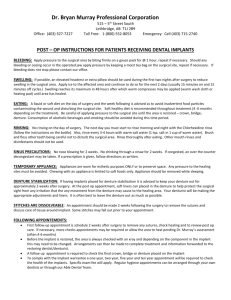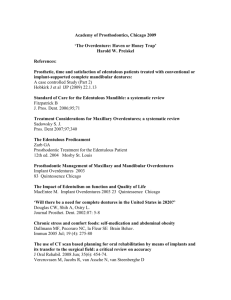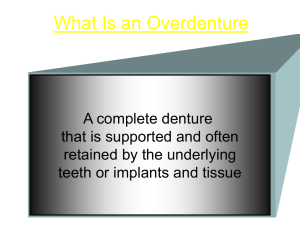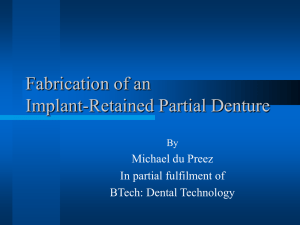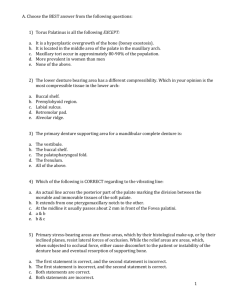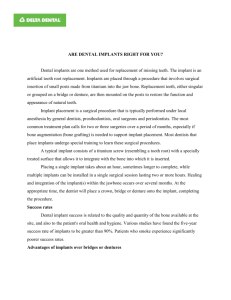Prostho sheet 26 - Clinical Jude
advertisement
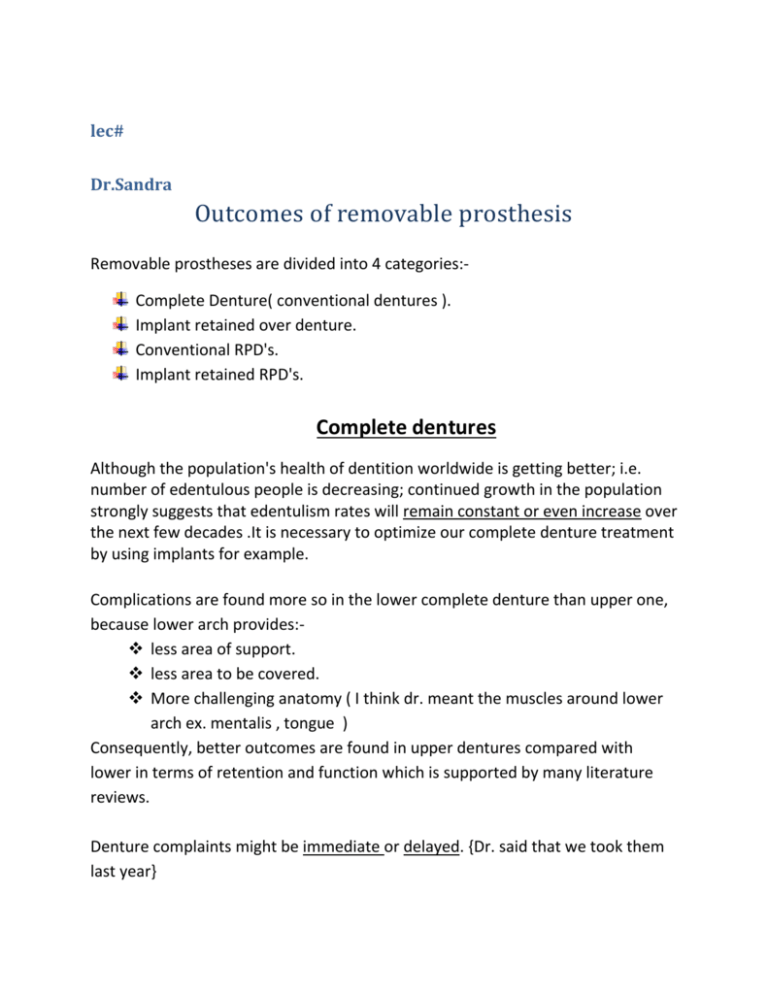
lec#
Dr.Sandra
Outcomes of removable prosthesis
Removable prostheses are divided into 4 categories:Complete Denture( conventional dentures ).
Implant retained over denture.
Conventional RPD's.
Implant retained RPD's.
Complete dentures
Although the population's health of dentition worldwide is getting better; i.e.
number of edentulous people is decreasing; continued growth in the population
strongly suggests that edentulism rates will remain constant or even increase over
the next few decades .It is necessary to optimize our complete denture treatment
by using implants for example.
Complications are found more so in the lower complete denture than upper one,
because lower arch provides: less area of support.
less area to be covered.
More challenging anatomy ( I think dr. meant the muscles around lower
arch ex. mentalis , tongue )
Consequently, better outcomes are found in upper dentures compared with
lower in terms of retention and function which is supported by many literature
reviews.
Denture complaints might be immediate or delayed. {Dr. said that we took them
last year}
Implant retained over denture
note: the standard of treating completely edentulous patient is upper
conventional complete denture with lower implant retained overdenture.
In lower implant retained overdenture we need two implants; they are placed in
canine area or lateral incisors area; depending on bone density.
Many systematic reviews which are randomized control trials (highest evidence)
conclude using retained overdenture is better than using conventional complete
denture for lower arch.
In these studies, they treated a group of edentulous patients first with
conventional denture then they converted the lower conventional denture to
implant retained overdenture for the same group , they did a questioner before
end of treatment and the same questionnaire was given to the group after 6
months of fabrication of implant retained overdenture , a comparison was done
based on difference of quality of life (quality of life stable analysis) they conclude
that Treating complete denture wearers with implants to support their denture
1. improves their chewing efficiency.
2. increases maximum bite force
3. it clearly improves satisfaction.
Until this time it's preferable to use upper complete denture with lower implant
retained over denture in treating completely edentulous patients
Becuase :1. there are a lot of evidence to propagate mandibular implant
supported overdenture
2. little research about maxillary implant supported overdenture ,so
the effect on quality of life is uncertain ( which is better maxillary
implant retained overdenture or maxillary conventional denture ) .
3. most of the time patients are very satisfied with conventional one
4. plus maxillary overdenture has more complication compared to
mandibular over denture.
5. they still don't know how many implants should be used for maxilla
and where we should put them( whether in canine / premolar area
due to little research )
NOTE: a certain indication to use upper implant supported over denture is
when a patient cannot tolerate palatal coverage at all and he wants a
horse shoe complete denture design ,here we can do implant overdenture
for upper, otherwise we don't use implant supported over denture in
maxilla .
implant attachments are divided into two categories:
1. non-splinted (solitary attachment )
locator attachment.
ball and socket.
2. splinted attachment
bar attachment.
These figures show two implants in the lower arch:
The figure above shows locator attachment, it is most
commonly used attachment nowadays because it has
several advantages over ball and socket attachment
(the picture below).
ball and socket is longer, this means the more developed the ridge
the less available space to restore, so we should go for shorter
attachment (locators).
Above the attachment there is the housing part (socket) of in the denture
above the housing part there is an acrylic base of the denture and above it
there are denture teeth.
the flat form of the locators is more which gives better retention.
Complications of Removable prostheses
The following mechanical complications of ISODs have been reported: { from
most common to least common}
1) Loss of retention of attachment systems
This happens because attachments wear over time (most common complication)
2) Replacement or activation of retentive elements
3) Loosening of screws
4) The need for relining or repairing the resin portion of the denture base
Implants reduce bone resorption around it but still bone resorbs in posterior area
(remember we only used two implants in anterior area)
bone resorption in posterior area in these cases might be not noticeable by
patients because gain of retention is primarily provided by attachments
which lead to torque forces around implant, hence fracture).
5) Pop-out of denture teeth,
6) Implant fracture.
note: The most common mechanical complication associated with over dentures
is maladjustment of the attachment system, regardless of the type of attachment
used.
OD patients who don't notice or care about their resorbed ridge come for
extractions after 6 months. Not only do they lose their money and time; but also,
the resorption around the remaining teeth would be irregular calling for
alveoplasty.
Should the attachment systems be splinted or be left unsplinted?
•No difference reported in implant survival rates between splinted and unsplinted
systems.
•Unsplinted design requires more prosthetic maintenance.
•The most common problem with mandibular ODs is replacement of the O-ring
on ball attachments.
•The number of mechanical complications associated with the Locator
attachment is lower than that for ball or bar attachments.
•that implant fractures most commonly occur with the ball attachment; they
found no implant fractures with the Locator attachment
The complications associated with the bar attachment
systems (splinted) are:
1) Due to their bulkiness.
2) Oral hygiene problems because it covers more of the soft tissues, so patients
can't go beneath these areas and to clean them.
3) The possibility of mucosal hyperplasia around the bar.
4) The need for adjustment of the clip.
5) More laboratory steps (both for casting and CAD/CAM).
- one of the bar indications is to correct the angulation and the misalignment (to
have a parallelism).
The following are some recommended solutions for reducing the incidence of or
solving the mechanical problems associated with ISODs:
1. The ODs must have proper extension and basal support. The fit of the denture
base must be checked periodically. If necessary, the denture base should be
relined or rebased as indicated.
2. The retentive elements of the attachment system must be checked and
replaced as necessary.
3. To avoid fracture of the denture base, ISODs should contain a metal
framework.
4. The design and thickness of the metal skeleton must allow sufficient thickness
of the acrylic resin.
4. Instructions regarding oral hygiene and maintenance of soft tissue around the
attachment systems are essential, especially with bar systems.
5. The distal extension of a bar attachment in resorbed mandibular ridges must
not be too long. The use of the proper length will prevent bar fracture.
6. Fabricating bar systems with CAD-CAM technology may lead to fewer
mechanical failures.
7. The placement of multiple implants for supporting an OD, specifically in the
maxilla, will simplify the repair of the prosthesis if an implant fails or fractures.
there is a photo in the slide showing an example of fracture through simple
attachment and this means the metal design in this area wasn't thick enough and
by biting forces it fractured. Therefore, we have to put a proper design to avoid
such complication.
Treatment outcomes in RPDs
Outcomes:
In terms of Esthetics and function
Patients mainly wear their dentures to improve their esthetics. RPDs are not the
best prostheses to provide function. In the long term, patients usually stop
wearing their RPDS.
The patients were mostly satisfied with their partial dentures. Only 2% of the
patients were completely unsatisfied with their mandibular RPDs, and 1% of
patients were completely unsatisfied with their maxillary RPDs.
A significant difference was registered between prosthodontists' and patients'
assessments of the quality of the RPDs (P < .001). Compared to the most satisfied
patients, the prosthodontists assessed the RPDs with the lower grades. Patients
could adapt more so than the dentist, offering better grades.
Complications:
These are mainly associated with two major factors. One attributed to the
dentists' faulty design; which is the commonest trigger to the onset of mobility.
This is especially important when the abutment teeth become mobile. Cases with
free end saddle , for instance, are frequently treated with other methods than
RPD; the latter being the ideal treatment choice. This makes up a faulty design,
contributing to earlier failure of the denture.
The second factor is Patients habits. All which comprise food impaction and
plaque accumulation due to absence of meticulous oral hygiene. This actually is a
strong contraindication to RPDs fabrication in the first place. Most patients
neglect OH. Consequently, caries on abutment teeth develop and patients
continue losing their rim until being converted to complete edentulism.
Partial over dentures:
These often constitute of distal saddle areas with retentive clasps
anteriorly. With implants ODs, a Kennedy Class 1 case can be converted to
Class 3; whereby retention posteriorly is as strong as anteriorly.
Attachments are similar to those used in complete prostheses. There are
also the conventional parts of the denture which contribute to retention.
The greatest advantage gained by these prostheses is the lack of clasps
which is particularly important in the maxillary arch in reference to
esthetics.
As we move the implant more posteriorly,
the balance between anterior and
posterior retention would be
compromised and the urge to incorporate
an anterior clasp much increases. It is very
important to place the implants
strategically i.e. to utilize the location of
the implant in case some alterations were
done in the future in terms of the number of implants as one example.
However, this does not mean that the implant preserves bone both
anteriorly and posteriorly. No guarantees are acquired, especially in the
posterior region after the passing of at least 5 years.
Partial over dentures are constructed when the patient is unsatisfied with a
previously fabricated conventional denture. There are also those who
prefer an advanced treatment to the previous one they got, but cannot
afford the costs of implants at the time. This is usually a mere transitional
phase; buying some time for the patient to get to a point where he/she
could afford implants.
Instant placement of implants in a recently extracted tooth socket reduces
the chances for future demand for bone graft. There would still be bone;
hence would spare the patient from undergoing future bone graft surgery.
This has the advantage of keeping the denture for a longer term.
When RPDs serve as transitional prosthesis, patients would be more
accepting of the prosthesis.
Meta analytical studies affect our latest treatments using implants.
Questionnaires concerning some treatment are handed out prior to
presenting practitioners with the latest evidence to compare their opinions
at both stages. The objective of one study is to investigate the impact of
meta analytic evidence in scientific literature on clinical decision making in
the field of oral implantology.
In the latest European conference with regard to Osseointegration in 2013,
a questionnaire of 20 questions was handed out, which relate to planning,
surgical and prosthetic stages. One question was whether to administer
antibiotics preoperatively or not. Generally, 2 g of amoxicillin 1 hr. prior to
surgery is favored. The antibiotic course lasts one week postoperatively.
Evidently, what significantly influences the success of this procedure is the
sole preoperative administration of amoxicillin. This is actually supported
by more than adequate evidence. No sufficient data is accepted in relation
to immediate loading of implants- i.e., being transmucosal (one staged) or
submucosal (two-staged). In other words, this is still a debatable topic.
Generally, the rate of expert members changing their opinions of some
matters was 37% after meta analyses were presented. In conclusion, a
clinician should be flexible to update one's tactics as meta analyses are
presented to them. Randomized controlled trials (RCTs )and systemic
reviews published at least 5 years prior to their date of access, are the most
credible source to refer to.
Done by : Farah Karaki, Fahed Aswad and Iya Ghassib
